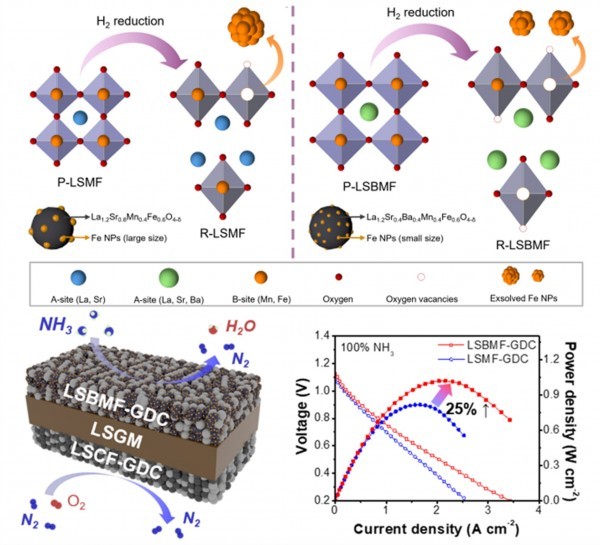
연구
Research Outcome
미래를 창조하는 포스텍 화학공학과
Lattice-Controlled Fe-Exsolved Perovskite Anodes for High-Performance and Durable Ammonia-Powered Electrochemical Systems
- Title of paper
- Lattice-Controlled Fe-Exsolved Perovskite Anodes for High-Performance and Durable Ammonia-Powered Electrochemical Systems
- Author
- [김원배 교수님 연구실] 격자 제어 기술이 적용된 Fe 용출 페로브스카이트 양극재를 통한 고성능 및 고내구성을 구현하는 암모니아 연료 전지 및 전기화학 시스템 솔루션 개발
- Publication in journal
- Chem. Eng. J. Volume 522, 15 October 2025, 168167
- Publication date
- 20251015

Abstract
Direct ammonia-powered solid oxide fuel cells (DA-SOFCs) offer a promising solution for ammonia-based electricity generation, operating efficiently at thermochemical NH3 decomposition temperatures. However, challenges such as metal agglomeration and nitridation hinder anode catalyst performance and durability. In this study, La0.6Sr0.2Ba0.2Mn0.2Fe0.8O3 (P-LSBMF) is developed as a high-performance DA-SOFC anode, emphasizing the synergistic effects of partial Ba substitution and Fe nanoparticle exsolution. This substitution facilitates the in-situ phase transition to La1.2Sr0.4Ba0.4Mn0.4Fe0.6O4-δ with exsolved Fe nanoparticles (R-LSBMF) under a reducing atmosphere, leading to lattice expansion, altering reduction behavior and improving catalytic activities for both of ammonia decomposition reaction (ADR) and hydrogen oxidation reaction (HOR). The R-LSBMF achieves nearly 100 % NH3 conversion at 800 °C, maintaining long-term operational stability exceeding 200 h with a maximum power density (MPD) of 1.019 W cm−2 under a pure NH3 fuel at 800 °C. Notably, long-term testing of ADR and electrochemical performance further reveal that the partially Ba-substituted R-LSBMF exhibits significantly higher durability compared to La1.2Sr0.8Mn0.4Fe0.6O4-δ with exsolved Fe nanoparticles (R-LSMF). These findings highlight R-LSBMF as a competitive promising anode material, advancing DA-SOFC technology along with improved performance and stability.



